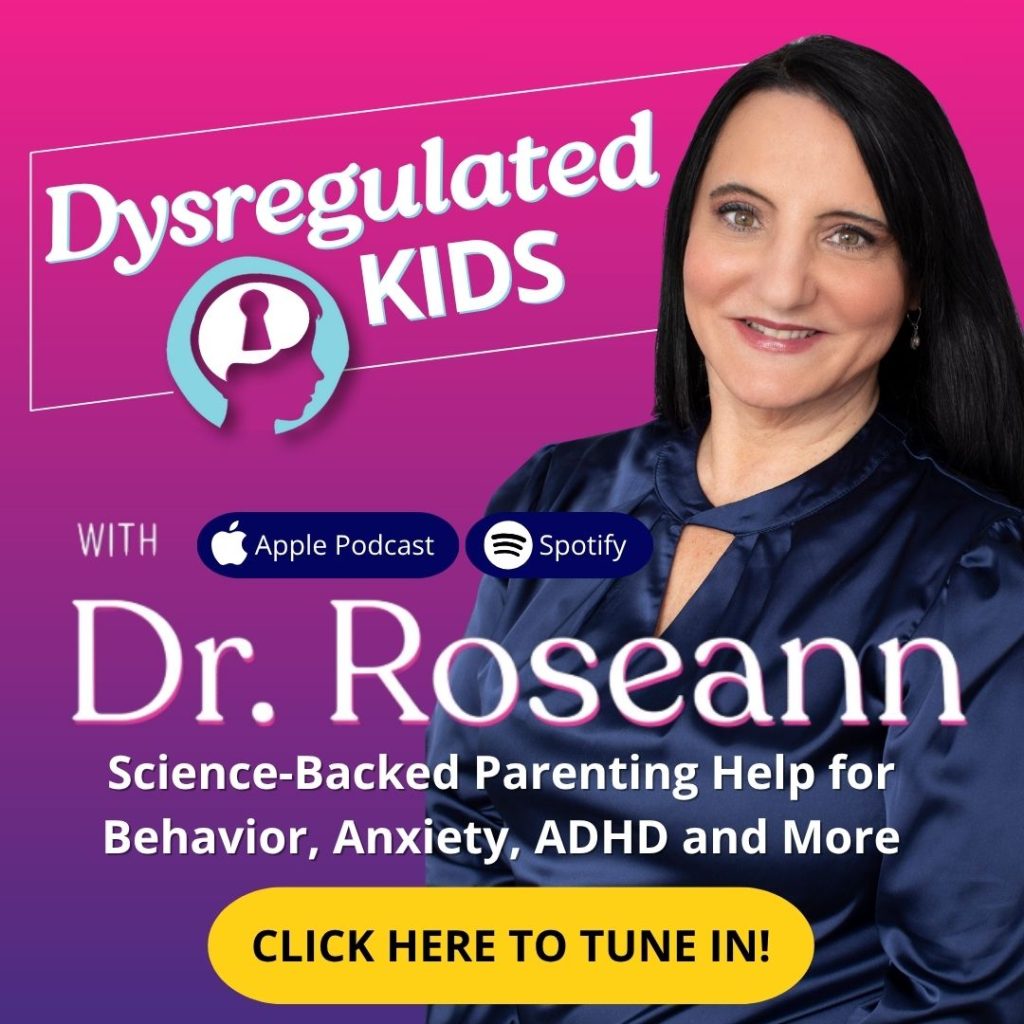Estimated Reading Time: 7 minutes
As a mom of a child with PANS, I know how terrifying it feels when your child suddenly starts to behave differently overnight. Understanding what a flare looks like and the underlying causes is one of the vital steps to managing it.
For the parents in my one-to-one program or for those that got my Natural PANS/PANDAS Calm Brain Kit, it is important to find a way to navigate these ups and downs due to a flare.
What is a PANS/PANDAS Flare?
A flare is a sudden, often severe worsening of symptoms in a child with Pediatric Acute-onset Neuropsychiatric Syndrome (PANS) or Pediatric Autoimmune Neuropsychiatric Disorders Associated with Streptococcal infections (PANDAS). These can happen within hours or days and dramatically affect emotions, behavior, and even functioning.
What are the Common Triggers of PANS and PANDAS Flare?

When the body can’t clear out what it doesn’t need—due to stress, genetics, or gut issues—it can create a loop of flare after flare.
Flares are often set off when the immune system goes into overdrive—usually from infections, but not always. Here are the most common triggers:
- Infections: Group A Streptococcus, Lyme, tick-borne illnesses, Epstein-Barr, COVID, and other viruses or bacteria
- Stressors: School pressure, family conflict, transitions, or even small changes in routine
- Allergens: Environmental and food allergens
- Gut Imbalances: Poor diet, meds, stress, or digestion issues
- Neuroinflammation: From toxins, infections, allergens, or stress
- Detoxification: When the body can’t clear out what it doesn’t need—due to stress, genetics, or gut issues—it can create a loop of flare after flare.
Why Do PANS and PANDAS Flares Happen?
When the immune system gears up to fight an infection, it creates antibodies that, in children with PANDAS, mistakenly attack the basal ganglia and trigger a sudden wave of neuropsychiatric symptoms—an autoimmune response.
This happens because of a process called molecular mimicry—when the immune system mistakes the body’s own tissues for harmful microbes. Some bacteria or viruses have molecules that look very similar to those in the brain or nervous system. So, instead of just attacking the infection, the immune system also attacks the brain by accident.
What are Common PANS and PANDAS Symptoms During a Flare?
Flares can look different for every child, but these are some of the most common signs parents notice:
- Sudden onset of OCD-like thoughts or compulsive behaviors
- Eating issues, including food restriction or fear-based avoidance (like ARFID or anorexia)
- Intense anxiety that seems to come out of nowhere
- Motor or vocal tics that appear or worsen
- Big mood swings, anger outbursts, or irritability
- Emotional storms and behavioral challenges that feel hard to manage
- Trouble focusing, forgetfulness, or learning regression
- Academic decline even in previously strong students
- Increased sensitivity to sounds, textures, lights, or smells
How Do Flares Cause Psychological Pressure?
Psychological stress happens when someone feels overwhelmed by demands they can’t meet (Cohen et al., 2007). PANS and PANDAS flares bring this stress to both children and their families.
For children, flares cause:
- Anxiety, fear, and confusion.
- A disrupted sense of normalcy.
- Emotional distress from the sudden changes.
For families, managing a flare means:
- Heightened worry and helplessness.
- Emotional exhaustion and strained relationships.
- Juggling treatment options, financial stress, and potential conflict.
Stress impacts everyone involved. Thus, building a strong support system and focusing on stress-relieving therapies can help stabilize the home environment.

How Do I Manage My Child’s PANS and PANDAS Flares?
Managing flares requires a combination of medical, therapeutic, and lifestyle approaches. Prompt medical attention, potential medication adjustments, and stress-relieving therapy are vital in supporting both the child and family during a flare.
What are the Important Aspects for Managing Flares?
- Prompt Medical Intervention to prevent escalation.
- Herbs, Supplements, and Homeopathy for quick relief and long-term support.
- Supportive Therapies like neurofeedback, PEMF, ERP, and CBT.
- Education and Awareness on symptoms and triggers.
- Daily Routine to manage your child’s symptoms and stress.
- Stress-Relieving Techniques like mindfulness, sensory support, physical activity, and sleep.
What are the Key Strategies in Managing My Child’s Behaviors During a Flare?
A study by Frankovich et al. (2017) outlines effective ways to support children with PANS/PANDAS, which are often triggered by infections like strep throat. They emphasize the use of antibiotics to treat and prevent recurring infections, along with medications that reduce inflammation and support immune function.
The primary goal is to manage symptoms and improve overall well-being through a combination of medical treatments and supportive therapies.
Here are practical strategies to help manage emotional outbursts and behavioral flares more effectively:
1. Share Your Calm
- Stay grounded by reminding yourself your child isn’t misbehaving on purpose. When you regulate your own nervous system, you model calmness and help de-escalate the situation.
2. Nonverbal Reassurance
- Use gentle body language and an open posture. Offer calm presence—maybe a hug if your child wants it—but don’t force physical contact.
3. Validate Feelings
- Let your child know their emotions are real and seen. Try saying, “I can tell you’re upset,” without rushing to fix or judge.
4. Create a Safe Space
- Set up a cozy, low-stimulation corner where your child can retreat and reset during meltdowns or flares away from stressors.
5. Use Distraction Techniques
- Redirect attention away from triggers using a favorite activity, music, humor, a sensory tool, or a simple change of scenery.
6. Set Clear and Consistent Limits
Boundaries provide structure. Explain them before a situation escalates and apply them calmly and predictably.
7. Develop a Signal or Code Word
- Create a signal or word that means ‘I need space’ or ‘I’m feeling overwhelmed,’ which your child can use when they start feeling agitated, allowing them to express the need for help without escalating behavior.

8. Offer Choices
- Give small options to help your child feel in control like “Want to draw or read?” Or, “One finger for space, two for a hug, three for sitting together.”
9. Practice Deep Breathing Together
- Teach calming breathwork when your child is regulated so they can use it later during distress. It doesn’t work mid-meltdown unless it’s been practiced beforehand.
10. Use Short and Simple Commands
- When emotions run high, keep language clear and brief.
11. Seek Professional Help
- If behaviors are intense or frequent, a child psychologist or psychiatrist can offer guidance, therapy, and specialized tools.
12. Monitor Triggers
- Keep a log of outbursts to uncover patterns. Understanding what leads up to behaviors can help you head them off before they explode.
13. Positive Reinforcement
- Notice and praise positive efforts—even small ones. This helps your child build emotional tools and confidence.

What are Activities that Relieve Psychological Stress in PANS/PANDAS?
Children with PANS/PANDAS often experience a sudden storm of symptoms—OCD, anxiety, tics, rage, sleep disruption. This can be deeply distressing, not just for them but for the entire family.
Common signs of psychological stress in affected children include:
- Panic attacks and heightened anxiety
- Irritability, aggression, or mood swings
- Trouble focusing or learning
- Difficulty sleeping or staying asleep
For families, the ripple effects may look like:
- Chronic worry and emotional exhaustion
- Strained family routines and relationships
- Physical symptoms like sleep loss or gut issues
- Financial pressure from ongoing medical care
Finding consistent, calming activities can ease emotional overload and provide stability. These tools are especially helpful during or after a flare, when regulation is hardest to access.
What are Evidence-Based Strategies to Reduce Stress for Children with PANS/PANDAS?
1. Art Therapy
Ever seen a kid pour their heart onto paper without saying a single word? Art gives them that space. Through painting, drawing, or even shaping clay with their fingers, children tap into deep feelings they can’t always explain.
It’s not just about creativity—it actually helps calm anxiety, boost brain function, and regulate those big emotions (Kramer, 2013).
2. Play Therapy
Kids don’t sit down and say, “I’m scared” or “I feel out of control.” But give them a few toys and a safe space? They’ll show you everything.
Play therapy lets kids explore their inner world through stories, characters, and pretend scenes—processing fear, stress, and frustration without the pressure of having the perfect words (Landreth, 2012).
3. Music Therapy
Music has a special way of calming nerves, easing anxiety, and lifting mood—it’s a soothing escape, whether your child’s listening or making their own tunes (Bradt & Dileo, 2014).
4. Animal-Assisted Therapy
Time with therapy animals increases oxytocin, reduces stress hormones, and provides comfort through unconditional emotional support. (Odendaal, 2000)
5. Physical Activity
Yoga, dance, or walking boosts endorphins, regulates mood, and improves sleep while helping release stored tension. (Rethorst et al., 2009)
6. Mindfulness Techniques
Breathing techniques, guided meditation, and mindful movement help children slow down, manage overwhelm, and tune into their emotions. (Semple et al., 2010)
7. Outdoor Time
Nature exposure lowers cortisol, lifts mood, and improves focus. Even a short walk in the fresh air can reset the mind and body. (Bratman et al., 2015)
8. Relaxation Techniques
Guided imagery, aromatherapy, or progressive muscle relaxation help shift the body out of fight-or-flight, support better sleep, and ease emotional tension. (Manzoli et al., 2009)
Parent Action Steps
FAQs
What should I do if my child suddenly becomes more anxious or agitated during a PANS/PANDAS flare?
Try to remain calm and provide reassurance. Offer a quiet space and engage in relaxation techniques like deep breathing or guided imagery to help them manage stress.
How can I tell if my child is experiencing a flare-up of PANS/PANDAS?
Watch for sudden changes in behavior, including increased anxiety, compulsive actions, mood swings, or difficulty concentrating. If these symptoms worsen rapidly, it could indicate a flare.
How important is maintaining a routine during a PANS/PANDAS flare?
Keeping a consistent daily routine provides stability and predictability, which can reduce anxiety and help your child feel more secure.
Citations
Bradt, J., & Dileo, C. (2014). Music interventions for mechanically ventilated patients. Cochrane Database of Systematic Reviews.
Bratman, G. N., Hamilton, J. B., & Daily, G. C. (2015). The impacts of nature experience on human cognitive function and mental health. Annual Review of Psychology, 66, 537-563.
Cohen, S., Janicki-Deverts, D., & Miller, G. E. (2007). Psychological Stress and Disease. JAMA, 298(14), 1685–1687. https://doi.org/10.1001/jama.298.14.1685
Kramer, E. (2013). Art as therapy with children. Routledge.
Landreth, G. L. (2012). Play therapy: The art of the relationship. Routledge.
Manzoli, L., et al. (2009). Progressive muscle relaxation and guided imagery for stress reduction in children: A meta-analysis. Journal of Pediatrics, 154(4), 522-526.
Odendaal, J. S. J. (2000). Animal-assisted therapy – magic or medicine? Journal of Psychosomatic Research, 49(4), 275-280.
Rethorst, C. D., et al. (2009). The effects of exercise on anxiety: A meta-analysis. Journal of Psychosomatic Research, 66(6), 589-604.
Semple, R. J., et al. (2010). Mindfulness-based cognitive therapy for children: A randomized controlled trial. Journal of Clinical Child & Adolescent Psychology, 39(3), 452-460.
Frankovich, J., Swedo, S., Murphy, T., Dale, R. C., Agalliu, D., Williams, K., Daines, M., Hornig, M., Chugani, H., Sanger, T., Muscal, E., Pasternack, M., Cooperstock, M., Gans, H., Zhang, Y., Cunningham, M., Bernstein, G., Bromberg, R., Willett, T., & Brown, K. (2017). Clinical Management of Pediatric Acute-Onset Neuropsychiatric Syndrome: Part II—Use of Immunomodulatory Therapies. Journal of Child and Adolescent Psychopharmacology, 27(7), 574–593. https://doi.org/10.1089/cap.2016.0148
Dr. Roseann is a mental health expert in PANS/PANDAS who frequently is in the media:
- Healthy Parenting Connector (Video) Why “My Kid is Acting Crazy” Might be PANS/PANDAS
- Living with Lyme (Podcast) Neurofeedback and biofeedback for PANS/PANDA
- Parenting Beyond the Headlines Talking About PANS, PANDAS, and Autoimmune Encephalitis
Always remember… “Calm Brain, Happy Family™”
Disclaimer: This article is not intended to give health advice and it is recommended to consult with a physician before beginning any new wellness regime. *The effectiveness of diagnosis and treatment vary by patient and condition. Dr. Roseann Capanna-Hodge, LLC does not guarantee certain results
Are you looking for SOLUTIONS for your struggling child or teen?
Dr. Roseann and her team are all about science-backed solutions, so you are in the right place!
Get A Clear Parent’s Path to Understanding and Managing Children’s Dysregulated Behaviors and Emotions with the
Self-Regulation Mastery Blueprint
© Roseann-Capanna-Hodge, LLC 2024









